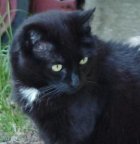
<img src="tabitha.jpg" width="140"
height="144" />
Actual size -- the best use of width= and
height=.

<img src="tabitha.jpg width="280" height="288" />
If you make a picture bigger, it will appear grainier.

<img src="tabitha.jpg" width="70" />
Note: if you specify only one of width or
height, the other dimension will be adjusted to
keep the original image's proportions.

<img src="tabitha.jpg" width="140"
height="72" />
Of course, there's no law that says you have to keep width and height proportional if you want a “fun-house mirror” effect.